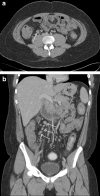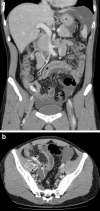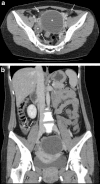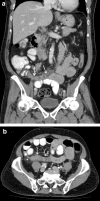The accuracy of pre-appendectomy computed tomography with histopathological correlation: a clinical audit, case discussion and evaluation of the literature
- PMID: 24879063
- PMCID: PMC4225066
- DOI: 10.1007/s10140-014-1243-z
The accuracy of pre-appendectomy computed tomography with histopathological correlation: a clinical audit, case discussion and evaluation of the literature
Abstract
The increasing use of computed tomography (CT) in acute appendicitis makes recognising the radiological hallmarks of the condition and its mimics vital. The differential diagnosis includes both appendiceal and nonappendiceal pathologies. The correlation between pre-appendectomy CT and post-appendectomy histopathology was audited retrospectively. Cases of clinico-histopathological discrepancy underwent blind peer-review, and possible improvements were discussed in the context of the medical literature. A grade for discrepancy was given based on the RADPEER scoring system, and interesting or discrepant cases were examined more closely to identify targets for education. Of the 199 procedures, 4 appendectomies were negative (histologically normal), 182 were positive (primary appendicitis) and 13 were incidental (another primary process caused inflammation). The positive predictive value for pre-appendectomy CT was 91.5 %, and the negative appendectomy rate was 2 %. There were many secondary pathologies, including neoplasia, tuberculosis and endometriosis. Although no CT reports missed a diagnosis that should be made "almost all of the time" and in 96 % of cases, the second, blinded radiologist agreed with the initial assessment, in 3 cases, a missed diagnosis altered clinical management; 2 were "understandable" misses but 1 was not. In five cases, a discrepancy was "understandable" but clinically insignificant. Overall, in comparison to the medical literature, the degree of clinico-histopathological correlation was good. Although identifying areas for improvement was challenging, after a pictorial review of four cases and a discussion of the medical literature, we present our audit results and some valuable learning points for use in the CT assessment of suspected acute appendicitis.
Figures




Similar articles
-
The use of computed tomography for the diagnosis of acute appendicitis in children does not influence the overall rate of negative appendectomy or perforation.Surg Infect (Larchmt). 2001 Spring;2(1):19-23. doi: 10.1089/109629601750185325. Surg Infect (Larchmt). 2001. PMID: 12594877
-
Imaging for suspected appendicitis: negative appendectomy and perforation rates.Radiology. 2002 Oct;225(1):131-6. doi: 10.1148/radiol.2251011780. Radiology. 2002. PMID: 12354996
-
Analysis of Appendiceal Neoplasms on 3544 Appendectomy Specimens for Acute Appendicitis: Retrospective Cohort Study of a Single Institution.Med Sci Monit. 2018 Jun 27;24:4421-4426. doi: 10.12659/MSM.908032. Med Sci Monit. 2018. PMID: 29947345 Free PMC article.
-
The diagnosis of acute appendicitis in a pediatric population: to CT or not to CT.J Pediatr Surg. 2003 Mar;38(3):367-71; discsussion 367-71. doi: 10.1053/jpsu.2003.50110. J Pediatr Surg. 2003. PMID: 12632351 Review.
-
Pitfalls in the CT diagnosis of appendicitis.Br J Radiol. 2004 Sep;77(921):792-9. doi: 10.1259/bjr/95663370. Br J Radiol. 2004. PMID: 15447972 Review.
Cited by
-
Chronic inflammation masquerading as an appendiceal tumour with peritoneal metastasis: the challenge of diagnosis and the lessons learnt.BMJ Case Rep. 2016 Feb 25;2016:bcr2015213911. doi: 10.1136/bcr-2015-213911. BMJ Case Rep. 2016. PMID: 26917796 Free PMC article.
-
Added value of double reading in diagnostic radiology,a systematic review.Insights Imaging. 2018 Jun;9(3):287-301. doi: 10.1007/s13244-018-0599-0. Epub 2018 Mar 28. Insights Imaging. 2018. PMID: 29594850 Free PMC article. Review.
-
Acute appendicitis: transcript profiling of blood identifies promising biomarkers and potential underlying processes.BMC Med Genomics. 2016 Jul 15;9(1):40. doi: 10.1186/s12920-016-0200-y. BMC Med Genomics. 2016. PMID: 27417541 Free PMC article.
-
Evaluation of CXCR1 as a possible diagnostic biomarker in acute appendicitis.Gastroenterol Hepatol Bed Bench. 2020 Winter;13(Suppl1):S106-S112. Gastroenterol Hepatol Bed Bench. 2020. PMID: 33585011 Free PMC article.
References
MeSH terms
LinkOut - more resources
Full Text Sources
Other Literature Sources
Medical

